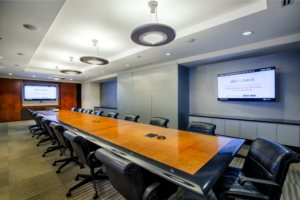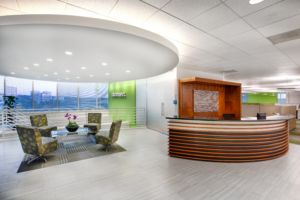Every workplace requires a unique solution for its office lighting. Your office design is unique to your company and your employees, so it’s safe to say there is no “one size fits all” lighting solution. Companies should consider investing in, and implementing, human-centered lighting which can provide a measurable return on productivity from employees.
 Human-Centered Office Lighting
Human-Centered Office Lighting
Both natural daylight and artificial light play an important role in making the workplace more efficient. Different activities require different types of lighting and levels of light. Although task lighting in modern office spaces tends to be a given, lighting solutions for non-task areas, such as the use of linear lighting, are also gaining more attention.
Try contrasting between the different office areas. Spaces which are not used as workstations, such as walkways, could have lower lighting levels. This contrast will generate a more exciting space and aid in a more dynamic design.
Office Lighting Positioning
Where lighting is located is also an important consideration, as light from surfaces or displays should not reflect directly into employee’s eyes. Rather than lighting an office environment equally, adding lighting on walls and ceilings will make the space appear larger, lighter and less claustrophobic.
Reducing Glare and Headaches
Glare can severely influence lighting quality in an office environment and is an extreme form of visual discomfort. When selecting office lighting, LED is an important factor. LED lighting is proving a popular choice for office spaces with an anti-glare, prismatic diffuser. Whether you choose a set of LED panels or a continuous linear LED lighting system, there are a variety of options. LED lighting give offices more options and versatility than ever before.
 Office Lighting and Color Temperature
Office Lighting and Color Temperature
By contrasting the office with different levels of illumination, it creates a more dynamic space. Areas of leisure don’t require the same level of illumination as workstations. Warmer lighting works well in breakrooms and creates a relaxing atmosphere away from the cool, white light needed for concentration and brain storming.
Because light synchronizes your circadian rhythm, a time-controlled lighting system can be used during the course of the day to adjust the color temperature and intensity of the office lighting. High levels of illumination and cool, indirect white light may be used to stimulate employees during the morning and early afternoons.
Lighting levels should fall at midday to late afternoon and become warmer. Artificial lighting should parallel natural daylight color temperature. Additionally, lighting should be adjusted to the shifting daylight hours of the various seasons.
Incorporating these office lighting design tips can boost productivity, concentration, and employee health. Lighting plays a very important aspect in the workplace and it’s best to ensure its optimized. If you have any design questions or would like professional help in office lighting, contact Planning Interiors Inc. at 470-545-4906.